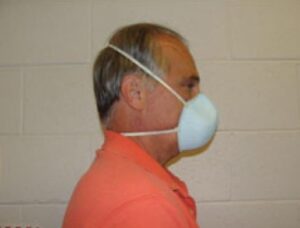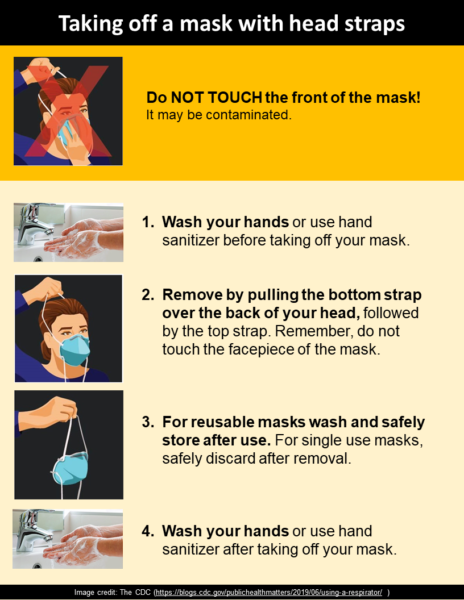As the pandemic progresses, more attention is being paid to incorporating design features that improve mask fit. To maximize the benefits of these design features, masks need to be put on (donned) and taken off (doffed) using techniques that people outside of the healthcare industries may not be as familiar with. In this post we talk about four key elements for ensuring and/or improving mask fit:
- Fitting the flexible nosepiece
- Improving mask fit with straps, ties, and ear loops
- How to put on (don) your masks
- How to take off (doff) your mask
#1. Fitting the Flexible Nosepiece

Most masks designed to seal to the face have a thin metal or plastic strip or bar at the top of the mask. This flexible nose piece is designed to mold to the nose and improve the fit of the mask by reducing gaps between the face and the mask.
To improve the seal of masks that have flexible nose pieces:
- Fit the nose piece to your face with both hands. Place your fingertips from both hands at the top of the metal nose clip (if present). Slide fingertips down both sides of the metal strip to mold the nose area to the shape of your nose. Note: The nose piece should not be bent or tented. Do not pinch the nosepiece with one hand.
| DIY Favorite Nose Piece: Coffee Bag Tin Ties. The larger surface area (5 ½” long by ¼” wide) compared to other nose piece options improves the contact area between the mask and the nose, improves fit, and decreases fogging of glasses. For information about other nosepiece options see: “Mask Materials” |
#2. Improving Fit with Straps, Ties, and Ear Loops

To improve the seal of masks that have head ties/straps/bands:
- Top strap placement: The top strap (on single or double strap masks) goes over and rests at the top back of your head (i.e., the crown of the head) [CDC, 2019; Roberge et al, 2014].
- Bottom strap placement: The bottom strap (if used) goes around the neck and is positioned below the ears (i.e., the base of the neck). For people with long hair, the bottom strap should be placed under (not over) the hair [CDC, 2019; Roberge et al, 2014].
To improve the seal of masks that have ear loops:
- Use ear savers (3D-printed, sewn, or crocheted): If using masks with ear loops, improvements in fit may be achieved using ‘ear savers’, which are DIY devices that reduce the tension on the users ears and improve mask fit. In some cases health centers have been able to significantly improve fit testing ‘pass’ rates using ear savers to improve the fit of K95s with ear loops (unpublished reports). Click here for an example of a health care provider improving surgical mask fit using a 3D-printed ear saver.
#3. Putting on (Donning) Masks
The following donning instructions are adapted from CDC guidance on face mask y respirator use for the general public. Click on the infographic to enlarge it, or read the details below.
How to Put On (Don) Your Mask
- Inspect the mask for damage. Do not use a mask that appears damaged. Also, do not allow facial hair, hair, jewelry, glasses, clothing, or anything else to prevent proper placement or to come between your face and the mask.
- Wash your hands or use hand sanitizer before donning mask.
- Fit the nose piece to your face with both hands. Place your fingertips from both hands at the top of the metal nose clip (if present). Slide fingertips down both sides of the metal strip to mold the nose area to the shape of your nose. Nota: The nose piece should not be bent or tented. Do not pinch the nosepiece with one hand.
- Extend the face mask under the chin. Both your mouth and nose should be covered. Fit the mask snugly against the sides of your face
- Secure mask to head with:
- One or Two Straps: The top strap (on single or double strap masks) goes over and rests at the top back of your head (i.e., the crown of the head). The bottom strap (if used) is positioned around the neck and below the ears (i.e., the base of the neck). For people with long hair, the bottom strap should be placed under (not over) the hair [Roberge et al, 2014].
- Two ties: Mask ties should be secured on crown of head (top tie) and base of neck (bottom tie).
- Ear loops: Carefully hook around the ears
- Check the seal of the mask to the face. Place both hands over the mask, take a quick breath in to check the seal. Breathe out. If you feel a leak when breathing in or breathing out, there is not a proper seal.
- Wash your hands or use hand sanitizer after donning mask.
Nota: If you have to continually adjust your mask, it doesn’t fit properly, and you might need to find a different mask type or brand.
The following video from the CDC demonstrates how N95s (starting at 1:36) and face masks (starting at 2:44) are donned in health care settings:
#4. Taking Off (Doffing) Masks
The following doffing instructions are adapted from CDC guidance on face mask y respirator use for the general public. Click on the infographic to enlarge it, or read the details below.
How to Take Off (Doff) Your Mask
- Wash your hands or use hand sanitizer before doffing mask.
- Be careful not to touch your eyes, nose, and mouth when removing your mask.
- Remove mask. Do not touch the front of the face mask. Handle only by the ear loops, ties, or straps
- Two straps: Remove the bottom strap by touching only the strap and bring it carefully over the head. Grasp the top strap and bring it carefully over the head, and then pull the respirator away from the face without touching the front of the respirator.
- One Strap: Grasp the top strap and bring it carefully over the head, and then pull the respirator away from the face without touching the front of the respirator.
- Two Ties: Carefully untie and pull away from face without touching the front.
- Ear loops: Carefully unhook from the ears and pull away from face without touching the front.
- For reusable masks wash and safely store after use. For single use masks, safely discard after removal.
- Wash your hands or use hand sanitizer before doffing mask.
The following video from the CDC demonstrates how to doff PPE, including N95s (starting at 2:29) and face masks (starting at 2:50), in health care settings:
Additional Links for Donning & Doffing Information
- CDC – Breathe Easy, Part 2: How to Properly Use a Respirator in an Emergency
- CDC – How to Wear Masks (Cloth Masks)
- WHO – How to Perform a Particulate Respirator Seal Check
References
- Yung CF, 2020. Poor Performance of Masks Secured Using Ear Loops. JAMA Intern Med. 2020 Nov 23. doi: 10.1001/jamainternmed.2020.6393. Epub ahead of print. PMID: 33226399. https://pubmed.ncbi.nlm.nih.gov/33226399/
- Sickbert-Bennett EE, et al, 2020. Filtration Efficiency of Hospital Face Mask Alternatives Available for Use During the COVID-19 Pandemic. JAMA Intern Med. 2020 Aug 11:e204221. doi: 10.1001/jamainternmed.2020.4221. Epub ahead of print. PMID: 32780113; PMCID: PMC7420816. https://pubmed.ncbi.nlm.nih.gov/32780113/
- Roberge RJ, et al, 2014. Effect of upper strap downward displacement on n95 filtering facepiece respirator fit factors: a pilot study. J Occup Environ Hyg. 2014;11(5):338-341. doi:10.1080/15459624.2013.866716 https://www.ncbi.nlm.nih.gov/pmc/articles/PMC4466548/
- Rottach DR, Lei Z, 2017. Stockpiled N95 Filtering Facepiece Respirator Polyisoprene Strap Performance. J Int Soc Respir Prot. 2017;34(2):69-80. https://www.ncbi.nlm.nih.gov/pmc/articles/PMC6198819/
- Vuma CD, et al, 2019. The Effect on Fit of Multiple Consecutive Donning and Doffing of N95 Filtering Facepiece Respirators. Ann Work Expo Health. 2019 Oct 11;63(8):930-936. doi: 10.1093/annweh/wxz060. PMID: 31504129. https://pubmed.ncbi.nlm.nih.gov/31504129/





4 pensamientos en “Improving Mask Fit and Seal”
Comentarios cerrados.